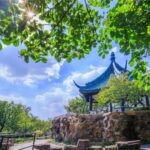Nan Garden, also known as ‘Tai Shi Fu’ among the local people of Taicang, was first established during the Ming Dynasty’s Wanli era. It served as a place for the prime minister, Wang Xijue, to appreciate plum blossoms and cultivate chrysanthemums, originally covering an area of eighteen acres. In the early Qing Dynasty, Wang Shimin, a painter and the grandson of Wen Su, expanded the garden and invited Zhang Nanyuan to oversee its construction. The collaboration between the artist and the craftsman transformed Nan Garden into a historical park where garden design and painting art are seamlessly integrated, but it was later destroyed by war. Starting in 1998, the garden was redesigned and planned according to original photographs and blueprints, relocating historically valuable ancient buildings from the old city’s renovation to Nan Garden. After six years of renovation, the garden has gradually restored its original attractions, including the ‘Gatehouse’, ‘Embroidered Snow Hall’, ‘Fragrance Tower’, ‘Great Return Pavilion’, ‘Crane and Plum Immortal Hall’, ‘Cold Jade Square’, ‘Tan Ying轩’, ‘Long Corridor’, and bridge pavilions. The garden is arranged around a central lake axis, with attractions distributed around it and a jade belt bridge as an embellishment in the middle. The inscription ‘Nan Garden’ on the gatehouse plaque was written by Dong Qichang. A small artificial hill has been constructed on the site of the original Taicang city wall to the south, with lush greenery. Lotus flowers sway on the lake surface, with light ripples. The most exquisite building in the garden is the Crane and Plum Immortal Hall, also known as the Flower Hall. The Great Return Pavilion was rebuilt in memory of Xu Shangying from Taicang. On display in the main hall upstairs are his ‘Great Return Qin Score’, ‘Xi Shan Qin Conditions’, ‘Wan Feng Ge Finger Method Secret Notes’, and rare valuable ancient qins. The garden is open all year round from 08:30 to 16:30, with an extended opening time from 07:30 to 17:00, and entry is stopped at 16:30.
Nan Garden – A Historic Scenic Spot in Zhouzhuang, Jiangsu
Nan Garden, also known as ‘Tai Shi Fu’ among the local people of Taicang, was first esta[...]









